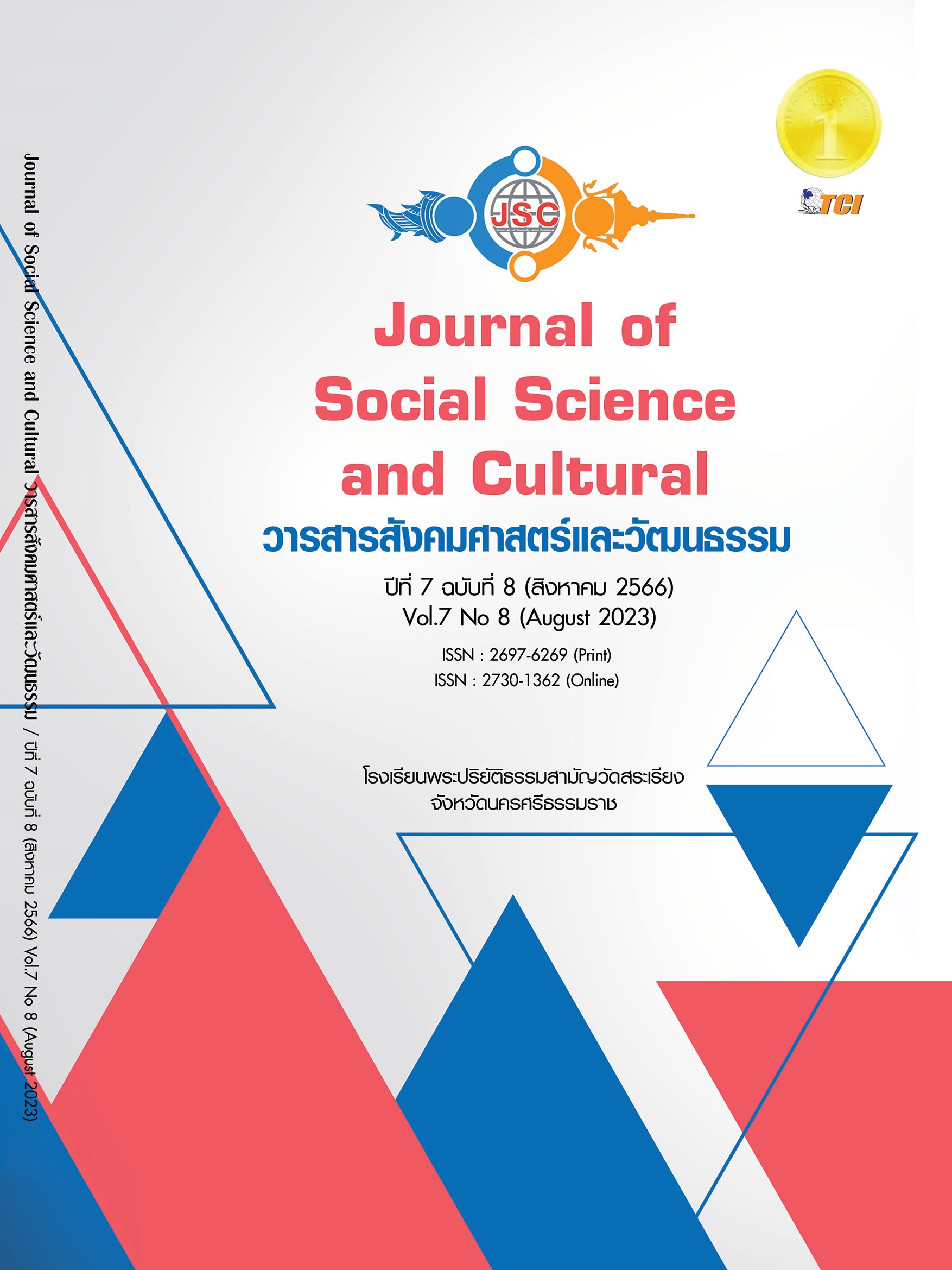การพัฒนาชุดกิจกรรมละครสร้างสรรค์เพื่อป้องกันพฤติกรรมการกลั่นแกล้ง รังแกผู้อื่นสำหรับเด็กในช่วงอายุ 9-10 ปี โรงเรียนวลีรัตน์วิทยา
Main Article Content
บทคัดย่อ
บทความวิจัยนี้ มีจุดมุ่งหมายเพื่อ 1. พัฒนาชุดกิจกรรมละครสร้างสรรค์การป้องกันพฤติกรรมการกลั่นแกล้งรังแกผู้อื่นของเด็กในช่วงอายุ 9-10 ปี โรงเรียนวลีรัตน์วิทยา 2. เปรียบเทียบผลการป้องกันพฤติกรรมการกลั่นแกล้งรังแกผู้อื่นของเด็กในช่วงอายุ 9-10 ปี โรงเรียนวลีรัตน์วิทยา กลุ่มตัวอย่าง คือ เด็กในช่วงอายุ 9-10 ปี ที่มีพฤติกรรมการกลั่นแกล้งรังแกผู้อื่น 3 ด้าน ร่างกาย คำพูด และการคุกคามในเชิงสัมพันธภาพ โดยเลือกแบบเจาะจง จำนวน 20 คน จากครูที่สอนในระดับชั้นประถมศึกษาปีที่ 4 มีระยะเวลาในการทดลอง ทั้งสิ้น 12 ชั่วโมง เครื่องมือที่ใช้ในการวิจัย ได้แก่ 1. แบบสังเกตพฤติกรรม 2. แผนการสอนจัดกิจกรรมละคร และ 3. แบบประเมินทักษะก่อนและหลัง วิเคราะห์ผลจากแบบสังเกตพฤติกรรม จำแนกออกเป็นก่อนและหลังการสอนโดยใช้กิจกรรมละครสร้างสรรค์ เพื่อวิเคราะห์ข้อมูลเด็กที่มีพฤติกรรมการกลั่นแกล้งรังแกผู้อื่น ก่อนและหลังการสอนด้วยกิจกรรมละครสร้างสรรค์ ผลการวิจัยพบว่า 1. ผลการพัฒนาชุดกิจกรรม การวิเคราะห์ค่าสอดคล้องชุดกิจกรรมจากผู้เชี่ยวชาญ ที่ระดับ 1.00 ซึ่งแสดงให้เห็นว่ารูปแบบการจัดกิจกรรมละครสร้างสรรค์เพื่อป้องกันพฤติกรรมการกลั่นแกล้งรังแกผู้อื่นสำหรับเด็กในช่วงอายุ 9 – 10 ปี มีความสอดคล้องกัน 2. ผลจากการเปรียบเทียบแบบสังเกตพฤติกรรมนักเรียน: พฤติกรรมการกลั่นแกล้งรังแกผู้อื่น ก่อนและหลัง แสดงให้เห็นว่านักเรียน 20 คน ที่ทำกิจกรรมละครสร้างสรรค์ มีการพัฒนาพฤติกรรมในทางที่ดีขึ้นตามลำดับ และ 3. ผลการเปรียบเทียบกิจกรรมละครสร้างสรรค์เพื่อป้องกันพฤติกรรมการกลั่นแกล้งรังแกผู้อื่นสำหรับเด็กในช่วงอายุ 9-10 ปี กิจกรรมที่ 1-9 แสดงให้เห็นว่า นักเรียนอยู่ในเกณฑ์การประเมินหลังทำกิจกรรม เกณฑ์ดี 19 คน, เกณฑ์พอใช้ 1 คน
Article Details
เอกสารอ้างอิง
กุลยา ตันติผลาชีวะ. (2543). การสอนแบบจิตปัญญา. กรุงเทพมหานคร: เอดิสัน เพรสโปรดักส์จำกัด.
ธนาภร สุขยิ่ง. (2553). ผลของการจัดกิจกรรมละครสร้างสรรค์ที่มีต่อความเชื่อมั่นในตนเองของเด็กปฐมวัย. ใน วิทยานิพนธ์การศึกษามหาบัณฑิต สาขาวิชาการศึกษาปฐมวัย. มหาวิทยาลัยศรีนครินทรวิโรฒ.
ปัญจวรา บุญสร้างสม. (2563). การพัฒนาเด็กปฐมวัยกับการแพร่ระบาดของโรคโควิด-19. เรียกใช้เมื่อ 14 มีนาคม 2563 จาก https://www.thaihealth.or.th/Content/54720
พรรัตน์ ดำรุง. (2547). การละครสำหรับเยาวชน. กรุงเทพมหานคร: สำนักพิมพ์แห่งจุฬาลงกรณ์มหาวิทยาลัย.
พวงรัตน์ ประเสริฐ. (2563). บูลลี่ไม่ใช่เรื่องเด็ก ๆ ความรุนแรงที่รอวันปะทุ. เรียกใช้เมื่อ 14 มีนาคม 2563 จาก https://www.komchadluek.net/news/edu-health/409587
พิรัชญา ภามนตรี. (2562). การพัฒนากิจกรรมละครสร้างสรรค์เพื่อส่งเสริมการปฏิสัมพันธ์ทางสังคมของเยาวชน:กรณีศึกษาเยาวชนในชุมชนอาคารทรัพย์สิน 26-7 เขตคลองเตย กรุงเทพมหานคร. ใน วิทยานิพนธ์การศึกษามหาบัณฑิต สาขาวิชาบริหารการศึกษา. มหาวิทยาลัยศรีนครินทรวิโรฒ.
มติชนรายวัน. (2561). ไทยอันดับ2 “เด็กรังแกกันในโรงเรียน” พบเหยื่อปีละ 6 แสนคน. เรียกใช้เมื่อ 14 มีนาคม 2563 จาก https://.www.dmh.go.th/news-dmh/view.asp?id=27485
มหาวิทยาลัยสุโขทัยธรรมาธิราช. (2524). จิตวิทยาพฤติกรรมเด็ก เอกสารประกอบการสอน. นนทบุรี: มหาวิทยาลัยสุโขทัยธรรมาธิราช.
มูลนิธิแพธทูเฮลท์. (2560). โครงการป้องกันและลดการใช้ความรุนแรงและการรังแกกันในสถานศึกษา. เรียกใช้เมื่อ 14 มีนาคม 2563 จาก https://path2health.or.th/
workpointnews. (2561). การกลั่นแกล้ง 6 ประเภทที่มักเกิดขึ้นในโรงเรียน พ่อแม่ห้ามนิ่งนอนใจ. เรียกใช้เมื่อ 14 มีนาคม 2563 จาก https://workpointnews.com/2018/10/11/%e0%b8%81%e0% b8%b2%e0%b8%a3%e0%b8%81%e0%b8%a5%e0%b8%b1


